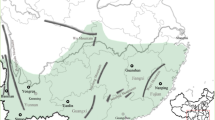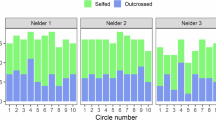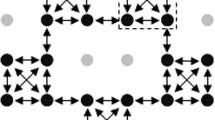Abstract
Inbreeding in homosporous plants, unlike angiosperms, can consist of two potential components: (1) fusion of gametes from the same gametophyte (intragametophytic selfing) and (2) matings between different gametophyte of the same parent (intergametophytic selfing). Although some workers maintain that intragametophytic selfing predominates in these populations, no attempt has been made to evaluate these two components of inbreeding in natural populations of homosporous ferns or lycopods. This paper gives a method for joint estimation of these two selfing rates, which uses data from two unlinked loci and makes the assumption of inbreeding equilibrium. The procedure was used to estimate selfing rates in six populations of two fern species. Weakly significant levels of intergametophytic selfing were found in one population of each species. The validity of the assumption of inbreeding equilibrium is discussed, and the requirement for several polymorphic marker loci is emphasized.
Similar content being viewed by others
Article PDF
References
Cockerham, C C, and Weir, B S. 1973. Descent measures for two loci with some applications. Theor Pop Biol, 4, 300–330.
Hedrick, P. 1987. Population genetics of intragametophytic selfing. Evolution, 41, 137–144.
Hedrick, P. 1989. The mating system and evolutionary genetics. In Wohrman, K. and Jain, S. (eds). Population Biology and Evolution. Springer-Verlag, Berlin.
Holsinger, K E. 1987. Gametophytic self-fertilization in homosporous plants: development, evaluation, and application of a statistical method for evaluating its importance. Am J Bot, 74, 1173–1183.
Kirkpatrick, R E B. 1988. An analysis of the mating system of Gymnocarpium dryopteris ssp disjunctum. M.S. Thesis, Washington State University, Pullman.
Klekowski, E J, Jr. 1969. Reproductive biology of the Pteridophta.IV. The Blechnaceae. Bot J Linn Soc, 62, 361–377.
Klekowski, E J, Jr. 1979. The genetics and reproductive biology of ferns In Dyer, A. F. (ed.) The Experimental Biology of Ferns, Academic Press, London, pp. 133–170.
Klekowski, E J, Jr., Baker, H G. 1966. Evolutionary significance of polyploidy in the Pteridophyta. Science, 153, 305–307.
McCauley, D E, Whittier, D P, and Reilly, L M. 1985. Inbreeding and the rate of self-fertilization in a grape fern, Botrychium dissectum Am J Bot. 72, 1978–1981.
Nei, M. 1986. Definition and estimation of fixation indices. Evolution, 40, 643–645.
Ritland, K. 1986. Joint maximum likelihood estimation of genetic and mating structure using open-pollinated progenies. Biometrics, 42, 25–43.
Slatkin, M. 1985. Rare alleles as indicators of gene flow. Evolution, 39, 53–65.
Soltis, D, and Soltis, P. 1986. Electrophoretic evidence for inbreeding in the fern Botrychium virginianum (Ophio-glossaceae). Am J Bot. 73, 588–592.
Soltis, D, and Soltis, P. 1987a. Polyploidy and breeding systems in homosporous Pteridophyta: a réévaluation. Am Nat. 130, 219–232.
Soltis, D, and Soltis, P. 1987b. Breeding system of the fern Dryopteris expansa: evidence for mixed mating. Am J Bot. 74, 504–509.
Soltis, D, Soltis, P, and Noyesr, R. 1988. An electrophoretic investigation of intragametophytic selfing in Equisetum arvense. Am J Bot, 75, 231–237.
Soltis, P, and Soltis, D. 1987. Population structure and estimates of gene flow in the homosporous fern Polystichum munitum. Am J Bot. 41, 620–629.
Soltis, P, and Soltis, D. 1988a. Genetic variation and population structure in the fern Blechnum spicant (Blechnaceae) from Western North America. Am J Bot. 75, 37–44.
Soltis, P, and Soltis, D. 1988b. Estimated rates of intragametophytic selfing in Lycopods. Am J Bot, 75, 248–256.
Soltis, P, and Soltis, D. 1990. Evolution of inbreeding and outcrossing in ferns and fern-allies. Pl Species Biol. (In press).
Soltis, P, Soltis, D, and Holsinger, K E. 1988. Estimates of intragametophytic selfing and interpopulational gene flow in homosporous ferns. Am J Bot. 75, 1765–1770.
Weir, B S. 1968. The Two Locus Inbreeding Function. PhD. Thesis, North Carolina State University, Raleigh, North Carolina.
Werth, C R, Guttman, S I, and Eshbaugh, W H. 1985. Electrophoretic evidence of reticulate evolution in the Appalachian Asplenium complex. Syst Bot. 10, 184–192.
Wright, S. 1969. Evolution and the Genetics of Populations Vol 2 The Theory of Gene Frequencies. University of Chicago Press, Chicago.
Author information
Authors and Affiliations
Rights and permissions
About this article
Cite this article
Ritland, K., Soltis, D. & Soltis, P. A two-locus model for the joint estimation of intergametophytic and intragametophytic selfing rates. Heredity 65, 289–296 (1990). https://doi.org/10.1038/hdy.1990.98
Received:
Issue date:
DOI: https://doi.org/10.1038/hdy.1990.98
This article is cited by
-
Self-fertilization in mosses: a comparison of heterozygote deficiency between species with combined versus separate sexes
Heredity (2007)
-
Allozyme variation in the sympatric ferns Culcita macrocarpa and Woodwardia radicans at the northern extreme of their ranges
Plant Systematics and Evolution (2007)



